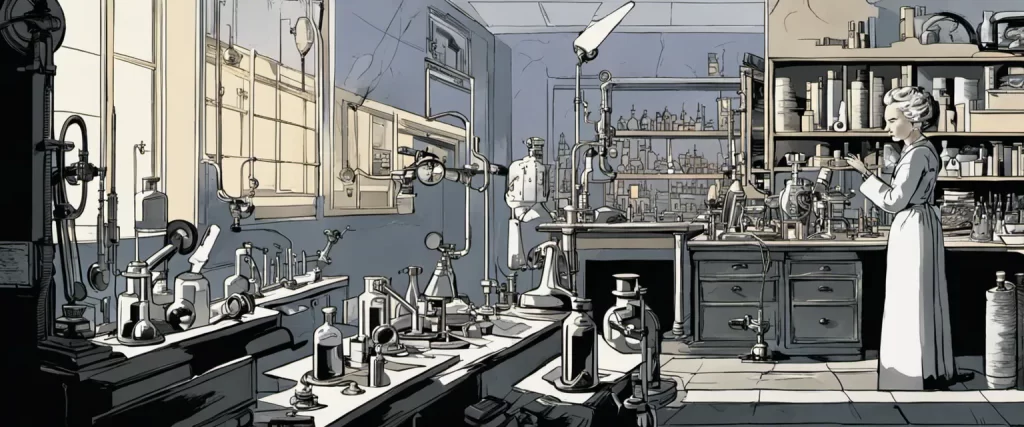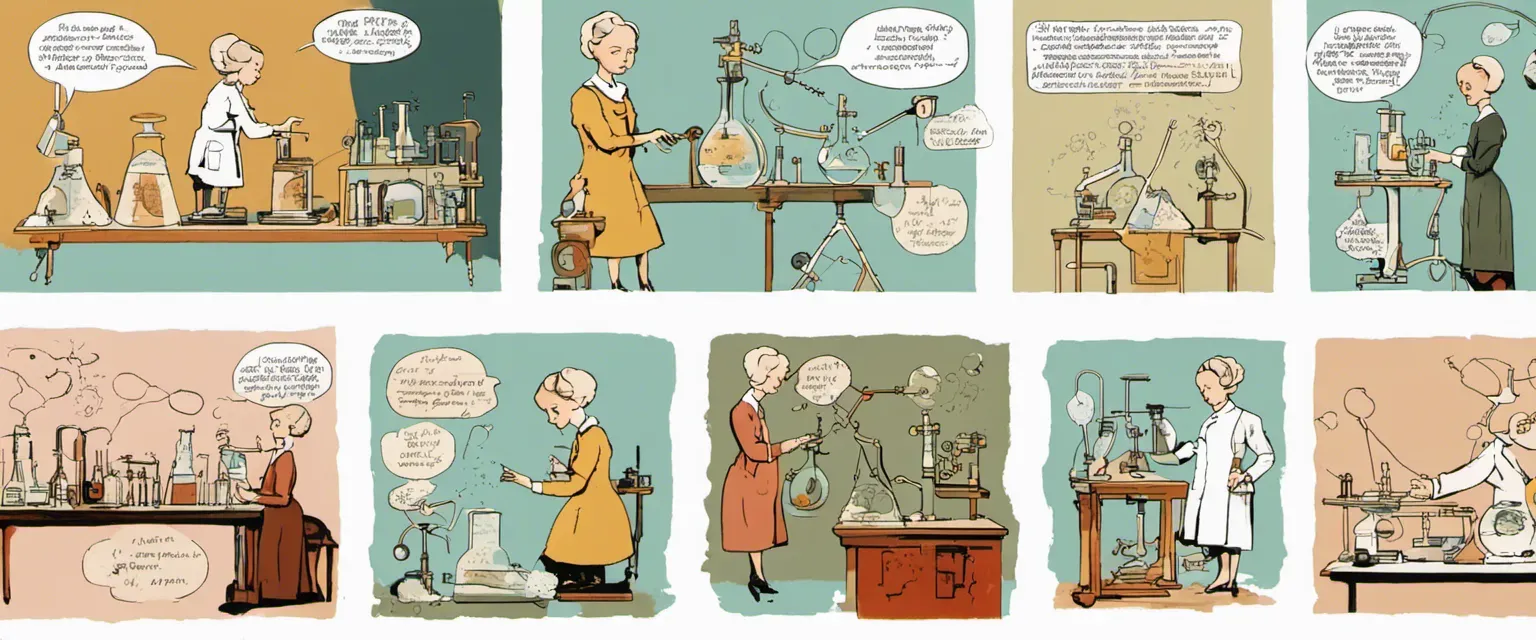——Madame Curie by Ève Curie & The Immortal Life of Henrietta Lacks by Rebecca Skloot
In the vast realm of literature, certain books have the power to unmask the hidden pieces of our collective history and delve into crucial societal issues, exploring the boundaries of ethics and scientific progress. Ève Curie’s biographical masterpiece, “Madame Curie,” and Rebecca Skloot’s groundbreaking work, “The Immortal Life of Henrietta Lacks,” exemplify such captivating narratives that chronicle the lives of remarkable women and their immeasurable contributions to science. Both books, written decades apart, encompass a tapestry of scientific brilliance, personal triumphs, and ethical dilemmas that compel readers to ponder the intricate balance between scientific advancement and human morality.
Madame Curie” sheds light on the life and legacy of Marie Curie, a resolute and trailblazing pioneer in the field of radioactivity. Authored by her own daughter, Ève Curie, the book offers a unique and intimate perspective, unveiling Marie Curie’s exceptional scientific achievements while sensitively exploring the challenges and sacrifices she faced as a woman in a male-dominated society. Seamlessly blending the realms of science, love, and ambition, Curie’s work continues to inspire generations, making her an emblematic figure in scientific history.
On the other hand, “The Immortal Life of Henrietta Lacks” ventures into a more recent chapter of scientific research, focusing on the gripping story of Henrietta Lacks, an African American woman whose cells were harvested by the medical community without her knowledge or consent in the 1950s. Authored by Rebecca Skloot, this compelling narrative explores not only the scientific breakthroughs that occurred due to Henrietta’s immortal cells but also the profound ethical questions they raise. Skloot intricately weaves together the Lacks family’s experiences and their pursuit of justice with the complex implications of biomedical research to create a deeply thought-provoking account.
Therefore, this comparative study seeks to analyze the fundamental similarities and differences between “Madame Curie” and “The Immortal Life of Henrietta Lacks,” examining the intricate interplay between scientific advancements, female empowerment, and the ethical ramifications that arise when technological progress disrupts personal agency. By juxtaposing these two books, we aim to shed light on the everlasting importance of these women’s contributions while exploring the complexities of scientific practices and the ethical challenges that persist through time.
Through our analysis, we will delve into the lives of Marie Curie and Henrietta Lacks, both of whom have left an indelible mark on the scientific world but in vastly distinct contexts. We will explore the societal implications surrounding female achievements in science, the ethical considerations regarding informed consent and tissue ownership, and the lingering impact of their respective legacies on modern biomedical research.
In sum, “Madame Curie” and “The Immortal Life of Henrietta Lacks” present us with rich narratives rooted in scientific brilliance, personal resilience, and ethical conundrums. Together, these works highlight the multifaceted nature of scientific progress, urging us to critically examine the ethical boundaries that must be reckoned with in the pursuit of knowledge and advancement for the betterment of society.
Brief Summary of Two Books
Madame Curie by Ève Curie
“Madame Curie” is a biography written by Ève Curie, the daughter of renowned physicist and chemist Marie Curie. The book offers an intimate and detailed account of Marie Curie’s life, work, and personal struggles.
The narrative begins with Marie Curie’s childhood in Poland and her relentless pursuit of education at a time when women were not encouraged to pursue scientific studies. It explores her move to Paris to study at the prestigious Sorbonne and her eventual partnership and marriage with Pierre Curie, a fellow scientist. Together, they made groundbreaking discoveries in the field of radioactivity, including the isolation of radium and polonium.
“Madame Curie” delves into the challenges faced by Marie Curie as a woman in a male-dominated scientific community, highlighting her dedication, perseverance, and exceptional intellect. It also discusses her scientific achievements, including winning two Nobel Prizes, making her the first woman ever to receive this honor.
The book also delves into Marie Curie’s personal life, including her role as a mother and the tragic loss of her husband Pierre in a tragic accident. It explores her subsequent relationship with Paul Langevin, which faced public scrutiny, stirring a scandal in Paris.
Ève Curie not only recounts her mother’s achievements but also provides an insight into the emotional and human side of Marie Curie. She portrays her as a woman of immense strength, facing adversity with grace and determination.
Overall, “Madame Curie” is a comprehensive and captivating biography that offers a compelling portrait of one of the most influential scientists in history, shedding light on Marie Curie’s life, struggles, and remarkable contributions to science.
The Immortal Life of Henrietta Lacks by Rebecca Skloot
“The Immortal Life of Henrietta Lacks” by Rebecca Skloot is a non-fiction book that tells the powerful and thought-provoking story of Henrietta Lacks, an African-American woman whose cancer cells were taken without her knowledge or consent and used for groundbreaking medical research. The book explores the impact of these cells, known as HeLa cells, on scientific and medical discoveries, as well as the ethical implications of using someone’s cells without their consent.
Skloot delves into Henrietta’s life, from her humble origins in Virginia to her battle with cervical cancer, which led to her cells being harvested. She examines the exploitation and profiteering that occurred within the medical and scientific communities due to the unprecedented success and durability of HeLa cells, leading to countless scientific breakthroughs, including the development of the polio vaccine and advancements in cancer research.
The book also sheds light on the personal struggles faced by Henrietta’s family in the aftermath of her death, as they were largely unaware of the significance of her cells and the immense contributions she unknowingly made to medical science. Skloot forms a close relationship with Henrietta’s daughter, Deborah, and together they embark on a journey to uncover Henrietta’s story and reclaim her legacy.
Skloot raises ethical questions about informed consent in medical research, racial disparities in healthcare, and the commercialization of human biological materials. She confronts the reader with the stark reality that a woman who died under tragic circumstances has had a lasting impact on science, yet her family struggled with poverty, lack of access to medical care, and limited knowledge of her contribution.
“The Immortal Life of Henrietta Lacks” is a compelling blend of scientific exploration, personal narrative, and social commentary. It exposes the complex and often overlooked history of medical research, while honoring the remarkable woman who unwittingly revolutionized modern medicine.
Comparison between Two Books

Similarities in remarkable women
Madame Curie by Ève Curie and The Immortal Life of Henrietta Lacks by Rebecca Skloot are two compelling books that shed light on the lives of remarkable women and their contributions to science. Despite being written about different women in different time periods, there are several similarities between these two books.
1. Inspiring Dedication to Science: Both Madame Curie (Marie Curie) and Henrietta Lacks exhibit an unwavering dedication to science. Madame Curie’s relentless pursuit of knowledge and her groundbreaking research on radioactivity led to significant advancements in the field of physics and chemistry. Similarly, Henrietta Lacks unknowingly contributed to medical science through the immortal HeLa cell line, derived from her cervical cancer cells, which has been instrumental in numerous scientific breakthroughs.
2. Gender Barriers and Discrimination: Both women faced significant gender barriers and discrimination in their respective times. Despite her exceptional scientific achievements, Madame Curie was often marginalized and faced resistance from male scientists who refused to recognize her contributions. Henrietta Lacks, an African American woman, faced racial discrimination and limited access to equal healthcare during her time.
3. Ethical Issues Surrounding Their Legacies: Both books raise important ethical questions regarding the treatment and use of their subjects’ cells. Madame Curie’s contributions to radioactivity eventually led to the discovery of radiation’s harmful effects, and her own exposure to radiation had severe health consequences. Henrietta Lacks’ cells were commercialized and used for scientific research without her or her family’s knowledge or consent, raising concerns about medical ethics and informed consent.
4. Impact on Science and Medicine: The contributions of Madame Curie and Henrietta Lacks had a significant impact on science and medicine. Madame Curie’s work on radioactivity laid the foundation for modern nuclear physics and has paved the way for advancements in cancer treatment and diagnostics. Henrietta Lacks’ HeLa cells have been used in countless experiments, leading to medical breakthroughs like the development of the polio vaccine and aiding in cancer research.
In conclusion, both Madame Curie and Henrietta Lacks were extraordinary women who defied societal expectations and made substantial contributions to science and medicine. Their stories highlight the challenges they faced, the ethical dilemmas surrounding their legacies, and their enduring impact on scientific advancements.
Divergences in remarkable women
Madame Curie by Ève Curie and The Immortal Life of Henrietta Lacks by Rebecca Skloot both explore the lives of remarkable women who made significant contributions to science and humanity. However, there are some notable divergences between the two books in terms of the women’s backgrounds, their scientific achievements, and the ethical implications of their work.
In Madame Curie, Ève Curie provides an intimate biography of her mother, Marie Curie, who became the first woman to win a Nobel Prize and the first person to win it twice in two different scientific fields. The book focuses on Marie Curie’s personal and professional struggles, her tireless dedication to her work, and her groundbreaking discoveries in the field of radioactivity. It highlights how Marie Curie’s scientific achievements fundamentally changed our understanding of the atomic structure and laid the foundation for modern physics and medical radiation treatments.
On the other hand, The Immortal Life of Henrietta Lacks centers around the story of Henrietta Lacks, an African American woman whose cells were taken without her knowledge or consent in the 1950s. These cells, known as HeLa cells, proved to be “immortal” and became instrumental in numerous medical breakthroughs, including the development of the polio vaccine and advancements in cancer research. Rebecca Skloot explores the ethical implications of Henrietta Lacks’ case, addressing the issues of medical consent, racial inequality, and the exploitation of marginalized communities in medical research. The book also sheds light on Henrietta’s family’s struggles to comprehend the significance of her contributions and the emotional toll it took on them.
One major divergence between the two books is the backgrounds of the women involved. Marie Curie, a Polish-born scientist, faced discrimination due to her gender in a male-dominated scientific community. Her journey to becoming a renowned physicist and chemist was characterized by her relentless determination and unwavering commitment to her research. Henrietta Lacks, on the other hand, was a disadvantaged African American woman who never received recognition or compensation for her cells’ contribution to medical science. She and her family were largely unaware of the impact her cells had until many years later.
In terms of their scientific achievements, Marie Curie’s work in radioactivity revolutionized the understanding of atomic physics. Her discoveries had significant implications for the development of nuclear energy and medical applications of radiation. Henrietta Lacks, while not directly involved in scientific research, unknowingly provided an invaluable resource to medical experiments and paved the way for numerous breakthroughs.
Furthermore, the ethical implications surrounding the women’s experiences differ in the two books. Madame Curie focuses more on Marie Curie’s personal struggles and the challenges she faced as a woman in science, but does not delve deeply into moral dilemmas or ethical controversies. In contrast, The Immortal Life of Henrietta Lacks delves extensively into the ethical questions raised by Henrietta’s case, sparking debates about medical consent, privacy, and the exploitation of vulnerable populations.
In conclusion, while both Madame Curie and The Immortal Life of Henrietta Lacks narrate the stories of remarkable women who made significant contributions, the books diverge in terms of the women’s backgrounds, scientific achievements, and the ethical implications surrounding their work. Marie Curie’s groundbreaking discoveries in radioactivity are juxtaposed with the ethical issues raised by the unauthorized use of Henrietta Lacks’ cells, shedding light on the complexities of scientific progress and its impact on the lives of extraordinary women.

Conclusion
Both “Madame Curie” by Ève Curie and “The Immortal Life of Henrietta Lacks” by Rebecca Skloot are highly regarded books that offer unique perspectives on important scientific figures.
“Madame Curie” is a biography, written by Ève Curie, the daughter of Marie Curie. It provides an intimate look into the life and achievements of one of the most iconic scientists in history. The book explores Marie Curie’s groundbreaking research on radioactivity, her struggles as a woman in a male-dominated field, and her personal and professional journey. This book offers a firsthand account of Marie Curie’s life and will be particularly interesting for those interested in her scientific contributions and the challenges she faced as a woman scientist.
“The Immortal Life of Henrietta Lacks” focuses on Henrietta Lacks, an African-American woman whose cells were taken without her consent and have since been vital in countless scientific discoveries. The book delves into issues of ethics, race, and the commercialization of scientific research. It explores the impact of Henrietta Lacks’ cells, known as HeLa cells, and the controversial story surrounding their origin. This book not only sheds light on an individual’s story, but also raises important questions about bioethics, medical research, and societal inequalities.
Which book is more worthy of reading depends on your personal interests and what you are seeking from a book. If you are more interested in a personal biography of a groundbreaking scientist, “Madame Curie” would be a great choice. On the other hand, if you are interested in scientific ethics, medical research, and the intersection of race and science, “The Immortal Life of Henrietta Lacks” would be a more fitting option. Both books offer valuable insights into the lives of influential figures and the impacts of their work, so you may want to consider reading both if the subjects appeal to you.



